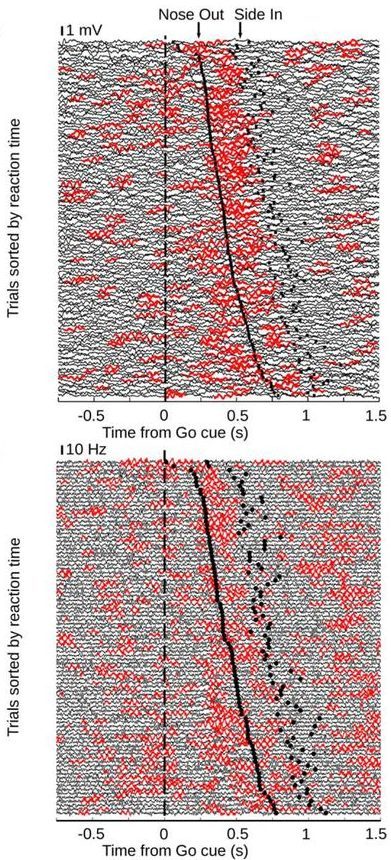Beta Oscillations

Figure 1: Brief epochs of beta oscillations (marked in red) related to sensory (dashed line) and motor events (black dots) in the rat striatum (top panel; Leventhal et al., 2012) and in a network simulation of the basal ganglia (bottom panel; Mirzaei et al., 2017).
While oscillations are often associated with cognitive functions, in Parkinson’s disease strong oscillations in the beta range (i.e. around ~20 Hz) emerge. These beta oscillations seem to be related to some of the severe motor symptoms of Parkinson’s disease such as akinesia and bradykinesia and involve neurons in the basal ganglia. However, beta oscillations occur also in the basal ganglia of healthy animals such as rats. Importantly, these beta oscillations occur in brief (100-200ms) epochs in relation to sensory and motor events in the local field potential (Figure 1, top panel; Leventhal et al., 2012). In contrast, in Parkinson’s disease beta oscillations are more prolonged, which might be an important aspect of the difference between healthy and pathological beta oscillations.
We study the relation between healthy and pathological beta oscillations. For example, we have recently shown that the same neural circuit that has been implicated in the generation of beta oscillations in Parkinson’s disease, can also generate the brief epochs of beta oscillations in healthy animals (Mirzaei et al., 2017). To show this we used a network model of the globus pallidus and the subthalamic nucleus of the basal ganglia. We exposed the network model to activity patterns that we had observed in recordings e.g. in the striatum of rats performing a behavioural task (Schmidt et al., 2013; Mallet et al., 2016). Interestingly, the model then generated beta oscillations with a striking similarity to what we had observed in the rat data (Figure 1).
This is important because it points to potential functional roles of these oscillations in the processing of sensory and motor signals. For example in Figure 1 the individual trials are sorted by the reaction of the rat in that trial. So the first black line at the top is the trial, in which the rat reacted fastest to the sensory cue with a motor response. As you can see across trials the pattern and timing of the beta oscillations in red changes, indicating a functional relation between beta oscillations and reaction time.
Where do we go from here? Next, we are investigating the impact of beta oscillations on information processing in simulated basal ganglia networks. The goal is to understand what beta oscillations might be good for and what goes wrong if there are too many of them…
One consequence of exaggerated beta oscillations in the basal ganglia is that neural activity in the basal ganglia output to the thalamus becomes more correlated. We have recently found that these correlations impair the transmission of motor signals (Mohagheghi Nejad et al., 2018).